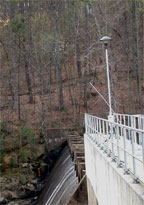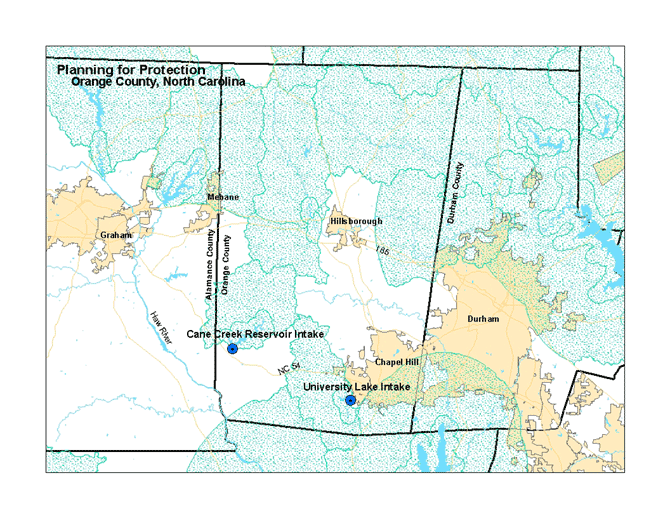Orange County
Planning for Protection: Orange County, North Carolina


Acting Entity: Orange Water and Sewer Authority
Contact Person: Ed Holland
Cost: $4.1 million
Population Served: 70,000
Water Supply: Reservoir, Cane Creek and University Lake
PWS ID: 0368010
Helping Organizations:
· Carrboro Board of Aldermen
· Chapel Hill Town Council
· Orange County Board of Commissioners
· Orange County Agricultural Extension Service
· Natural Resource Conservation Service (NRCS)
· Conservation Trust for North Carolina (CTNC)
· North Carolina Land and Water Fund
Funding Sources:
· $100-125,000 from OWASA for planning study in University Lake Watershed
· $160-170,000 from OWASA for planning study in Cane Creek Watershed
· $800,000 from North Carolina Land and Water Fund for land acquisition in Cane Creek Watershed
· $3,000,000 from OWASA ratepayers for land acquisition in Cane Creek Watershed
Features:
· OWASA recognized need for the public to be involved in the planning process, and public opinion shaped a great deal of this effort.
· The planning effort that went in to this project was a key component.
Summary: Orange Water and Sewer Authority furnishes drinking water from University Lake and the Cane Creek Reservoir to approximately 70,000 people in Carrboro, Chapel Hill, and the University of North Carolina at Chapel Hill.
A residential subdivision proposed outside of Carrboro during the mid-1980s would have required the extension of OWASA water and sewer lines into the University Lake watershed. The ensuing public debate about whether or not the provision of public water and sewer service extensions help protect the water supply or simply make it more susceptible to pollution prompted OWASA to commission a planning study to determine the impact of new development on University Lake water quality. The study concluded that new development would increase water quality risks unless nutrient runoff was managed through either of two approaches: (1) Non-structural practices, such as zoning and land use restrictions; or (2) An aggressive program of structural practices that would include the construction and maintenance of numerous stormwater management facilities. Local governments with jurisdiction in the watershed adopted the non-structural (zoning) approach and required that all new residential lots be at least five acres in size, except for existing lots that could be subdivided into as many as five two-acre lots. It was also agreed that extensions of OWASA water and sewer lines would not be allowed into the University Lake watershed.
Cane Creek was impounded in 1989 to supplement the community's water supply. As with University Lake, approximately 90 percent of the Cane Creek watershed is located in Orange County. Prior to 1997, OWASA had acquired 1,637 acres of Cane Creek watershed land, including 600 acres of shoreline buffer purchased when the reservoir was developed, 508 acres of wildlife mitigation land, and 529 acres of additional land purchased between 1991 and 1997 for water quality protection.
To further protect its $20 million investment, OWASA completed a comprehensive study of the reservoir and watershed in 1996. Results indicated that water quality was good, but not pristine, and subject to degradation from land conversion and suburban development. Recommended goals included the management of nutrient loading so that median summer chlorophyll-a concentrations would not exceed 25 ug/L as development continues. A long range management plan was adopted by the OWASA Board of Directors in October 1997 and included the following principle recommendations:
1. Large-lot rezoning (5-acre minimum lots for residential development) or mandatory cluster development of 18,000+ acres in Orange County.
2. Acquisition by OWASA of 1,265 additional acres of land.
3. Modification of the raw water intake structure to provide selective withdrawal of highest quality water.
4. Future construction and operation by OWASA, if necessary, of a 40-acre tributary subimpoundment to trap pollutants before they enter the reservoir.
Rezoning was implemented by the Orange County Board of Commissioners, which has land use jurisdiction for 90 percent of the watershed; recommended modifications to the Cane Creek Reservoir intake structure are currently underway and will be completed later in 2003; and, OWASA has protected 748 acres of its 1265-acre acquisition goal through 14 land transactions since 1998. These have included 263 acres purchased in fee simple and 485 acres under conservation easements.


